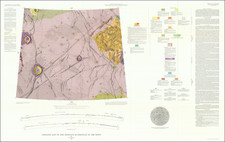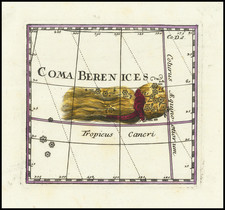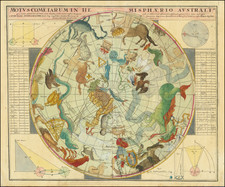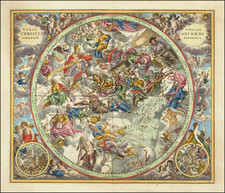A Magnificent Depiction of Orion's Nebula. Made by the "Audubon of the Sky", Etienne Trouvelot.
This is a beautiful color lithograph showing Orion's Nebula made by Etienne Trouvelot, relating his observations made in the fall of 1874. The chromolithograph was published as part of Trouvelot's Astronomical Drawings set of 15 plates by Charles Scribner's Sons in 1882.
Trouvelot's drawings are known as some of the best images of the sky ever made. Trouvelot's work was very important at the time, as it provided important images of the stars, planets, and phenomena of the sky at a time when popular interest in astronomy was growing, but photography had not yet become advanced enough to capture such dark images. Trouvelot's images are recognized as the last of the great images of the night sky that surpassed the photography of their day.
The object shown is a vast swath of gas and dust spread about the night sky, twenty-four light-years across. Like all nebula, it represents a part of space where planets and stars are born. Some of the youngest stars in the galaxy are in Orion's belt. As the gas cloud cools, it collapses on itself, amassing to create objects. Due to the vast amounts of energy and loose gas, amazing phenomena occur as streams of particles and young stars collide. The nebula exists on a time scale not that different that of the existence of humans. The nebula formed around the timing of the oldest human fossils, and will only exist as it does now for less than a hundred thousand additional years.
Trouvelot provides a useful description of the objects shown as follows in his Trouvelot Astronomical Drawings Manual:
This nebula, which is one of the most brilliant and wonderful of telescopic objects, readily visible to the naked eye as a patch of nebulous light immediately surrounding the middle star of the three which form the sword of Orion, and a little south of the three well-known stars forming the belt. The small stars in this, as in other Plates of the series, are somewhat exaggerated in size, as was unavoidable with any mode of reproduction that could be employed. The bright pentagonal centre of the nebula is traversed by less luminous rifts, the several subdivisions thus outlined being irregularly mottled as if by bright fleecy clouds. Toward the lower part of this bright pentagonal centre is a comparatively dark space containing four bright stars which form a trapezium and together constitute the quadruple star Theta Orionis, which, to the naked eye, appears as the single star in the centre of the sword. On three sides of the central mass extend long bright wisps, whose curves fail, however, to reveal the spiral structure often attributed to this nebula. On the east a broad wing, with wave-shaped inner border, stretches southward. East of the trapezium are two especially noticeable dark spaces. Close to the main nebula on the north-east, a small faint nebula surrounds a bright star, and a branch from another faint stream of nebulous matter forming a loop to the southward, encloses the nebulous star (Iota Orionis) shown at the top of the Plate.
Rarity
Trouvelot's prints were originally intended for the astronomical and scientific community and most of the larger US observatories purchased copies of the portfolio. In 2002, B.G. Corbin undertook a census to determine the number of surviving copies of the complete set of 15 prints and was only able to confirm the existence of 4 complete sets.
Trouvelot (1827-1895) was born in Guyencourt, Aisne, France. During his early years he was apparently involved in politics and had Republican leanings. Following a coup d'état by Louis Napoleon in 1852, he fled or was exiled with his family to the United States, arriving in 1855. They settled in the town of Medford, Massachusetts, where he worked as an artist and nature illustrator. In both 1860 and '70 census, his occupation is listed as lithographer.
Trouvelot had an interest as an amateur entomologist. In the U.S., silk-producing moths were being killed off by various diseases. Trouvelot brought some Gypsy Moth egg masses from Europe in late 1866 and was raising gypsy moth larvae in the forest behind his house. Trouvelot apparently understood the danger posed by the Gypsy Moths and housed them under netting. Unfortunately, an egg mass went missing during a storm in 1869. He immediately realized the potential problem he had caused and notified some nearby entomologists, but nothing was done. This story has been called into question, based on earlier reports Trouvelot made that his netting had holes in it large enough for robins to fit through and eat his caterpillars.
Shortly following this incident, Trouvelot lost interest in entomology and turned to astronomy. In this field he could put his skills as an artist to good use by illustrating his observations. His interest in astronomy was apparently aroused in 1870 when he witnessed several auroras.
When Joseph Winlock, the director of Harvard College Observatory, saw the quality of his illustrations, he invited Trouvelot onto their staff in 1872. In 1875, he was invited to the U.S. Naval Observatory to use the 26-inch refractor for a year. During the course of his life he produced about 7,000 quality astronomical illustrations. 15 of his most superb pastel illustrations were published by Charles Scribner's Sons in 1881. He was particularly interested in the Sun, and discovered "veiled spots" in 1875. Besides his illustrations, he published about 50 scientific papers.
In 1878, Trouvelot and his son traveled to Creston, Wyoming Territory, to observe the total eclipse of the Sun on July 29.
By 1882, Trouvelot had returned to France and joined the Meudon Observatory. He worked there under Jules Janssen, a leading solar astronomer. However, Trouvelot resented the cloudy French sky, which impeded his observations. He traveled with Janssen to the Caroline Islands in the South Pacific to observe the total eclipse of 1883 and attempt to discover the phantom intra-Mercurial planet.
Trouvelot died at Meudon on April 22, 1895. At the time he was working on a monograph of Mars. His son, George, hoped to find a publisher for Etienne's drawings of Mars, but was unsuccessful. The whereabouts of almost all of the drawings left by Trouvelot to his family are currently unknown.













![[The April, May & June Sky -- Virgo, Leo, Libra, Leo Minor, Ursa Major, Argo Navis, The Centaur, Hydra, Crater, Curvus Noctus, Boots, Bernices Hair, Asterion . . . ]](https://storage.googleapis.com/raremaps/img/small/87115.jpg)
![[Perseus]](https://storage.googleapis.com/raremaps/img/small/83167.jpg)